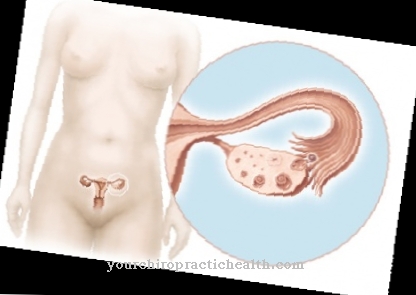With the medical term Perfusion pressure is the term used to describe the pressure with which an organ or tissue structure to be supplied is supplied with blood. Mathematically, the level of the perfusion pressure results from the difference between the blood pressure in the arteries and the tissue pressure moving in the opposite direction. The value varies depending on the area of the body.
What is Perfusion Pressure?

The term perfusion pressure is a technical term in human medicine. It indicates the pressure with which an organ or tissue is supplied with blood. Depending on the area of the body, there is a specific measured value that has its own meaning as a sub-term. A distinction is made between the following values, for example:
- Pulmonary perfusion pressure: This is the perfusion pressure with which the lungs are supplied. It results from the difference between the mean value of the pulmonary artery pressure (PAD) and the pressure of the left arteries.
- Coronary Perfusion Pressure: The pressure of the coronary arteries (coronary arteries) that supply blood to the heart muscle.
- Ocular Perfusion Pressure (OPD): This describes the perfusion pressure in the human eye. It results from the difference between intraocular pressure and arterial pressure.
- Cerebral Perfusion Pressure (CPP): The pressure at which blood is supplied to the brain. It results from the difference between the pressure with which blood is pumped into the brain (MAP pressure) and the intracranial pressure.
Function & task
The perfusion pressure is used in medicine as one of the most important indicators for determining human health. Although every person has an individual perfusion pressure, which changes depending on the specific situation, age and environment, significant conclusions can be drawn about the state of health based on average values.
For example, the perfusion pressure of the eye, the ocular perfusion pressure (OPD), is an important factor in the prognosis and diagnosis of glaucoma. Because this is relevant for the supply and activity (or inactivity) of the optic nerve. If the ocular perfusion pressure is not only temporarily disturbed (pressure too low), the changes in the eye that are responsible for glaucoma are caused.
The cerebral perfusion pressure (CPP), which indicates the speed of pressure to the brain, can provide insightful conclusions about a patient's health. Because the adequate blood supply to the brain or the entire skull area is indispensable. Undersupply can lead to death.
These descriptions can also be applied to the pressure of the coronary arteries (coronary perfusion pressure). Undersupply can lead to cardiac arrest and ultimately death.
Illnesses & ailments
Insufficient cerebral perfusion pressure (perfusion pressure of the brain) can cause a drop in pressure, which eventually leads to insufficient blood flow to the brain or a complete cessation of blood flow. This so-called ischemia is mostly due to a change in the blood vessels. These can be the result of an embolism or thrombosis.
Ischemia can be temporary or permanent. The longer it lasts, the greater the risk of permanent tissue damage. In severe cases, it is referred to as critical ischemia. The ischemia causes a cellular metabolic disorder. It is often accompanied by a lack of oxygen.
The processes set in motion by this can lead to the death of cells (cell death or necrosis) and thus trigger an infarction. This is not only possible in the heart area (myocardial infarction), but can also occur in the brain area (cerebral infarction or ischemic stroke). The consequences vary depending on the severity of the infarction. If immediate care is not taken, the heart attack can be fatal.
The period of time in which the pressure loss caused by ischemia can be withstood without permanent damage (ischemia time) varies from organ to organ. According to the literature, the ischemia time of the brain is only a few minutes. For organs that can be transplanted (e.g. kidneys, heart, liver, etc.) it is much higher with up to a maximum of 12 hours.
Furthermore, if the perfusion pressure in the eye is too low (the ocular perfusion pressure), the formation of cataracts (Latin: glaucoma) can be promoted. Essentially, the concept of cataracts is used as a collective term for various diseases of the eye. What they all have in common is that they damage the retina and thus impair vision.
Glaucoma often only develops after the age of 40. The frequency increases with age. An untreated cataract leads to blindness. Early diagnosis and treatment is therefore of particular importance.
The symptoms of glaucoma increase with the duration of the illness. At first they are hardly recognizable. Patients report an increased feeling of pressure in the eye. Often there is also a decrease in vision. A narrowing of the field of vision is also characteristic. This symptom is often associated with a loss of contrast perception. A photophobia is also typical.
In the course of cataract treatment, great care is taken to ensure adequate ocular perfusion pressure to prevent the symptoms that have already occurred from worsening. Blood pressure is also influenced. The scope of therapy and the corresponding measures depend on the individual case. An operation as well as the allocation of medication are possible.








.jpg)



















